By Paul Cigan, DNR Forest Health Specialist, Hayward;
Paul.Cigan@wisconsin.gov or 715-416-4920
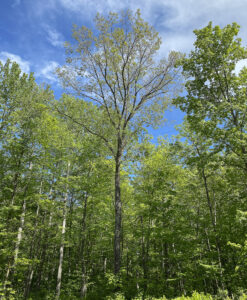
Many oaks across northern Wisconsin displayed partially defoliated, thin, and yellow-tinted crowns caused by defoliation from the oak leafroller and oak leaftier. / Photo Credit: Paul Cigan, Wisconsin DNR
A three-year-long outbreak of oak leafroller moth and oak leaftier moth—two native, early-season oak defoliators—continued this spring in northern Wisconsin, leaving behind tens of thousands of acres of oak-dominated forest with scattered, widespread defoliation.
Partially defoliated, thin and yellow-tinted crowns were visible across portions of Barron, Rusk, Sawyer and Washburn counties, as well as areas in Florence, Forest, northern Marinette and Vilas counties.
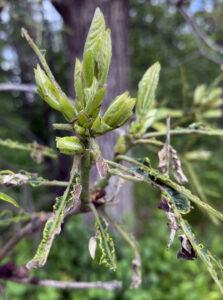
Most defoliated oaks will produce a second flush of leaves from buds on defoliated twigs for the remaining growing season, as shown by this bur oak. / Photo Credit: Paul Cigan, Wisconsin DNR
Looking closely at affected leaves can reveal distinguishing features between the feeding style and caterpillars of these two moth species:
- Oak leafrollers typically roll up a leaf, often concealing a feeding caterpillar with pale legs or a developing pupa. Adults are yellow with light brown bands.
- Oak leaftiers typically fold over a section of leaf and bind it with strands of silk, where a caterpillar with dark-colored legs may be seen feeding within. Adults are creamy brown, with a darker oblique band across their wings.
Caterpillars of both species can occasionally be observed dangling from twigs on silk threads. Oak leafroller has caused most of the defoliation among these two moth species during the present outbreak.
The outbreak, which began in May 2022 and correlated with a multi-year growing season drought cycle, appeared to reach its peak this season in both severity and extent of defoliation. The reversal of the drought cycle this spring, however, improves the chances that the high populations of these two moth species will decline and that the most heavily impacted tree species, northern red and pin oak, will have an improved outlook for recovery from the stress of defoliation.
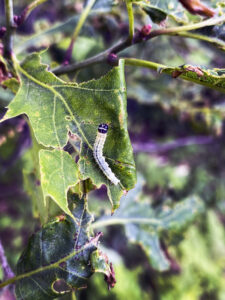
Oak leafroller rolls up leaves with silken threads and has a black-colored head capsule. / Photo Credit: Paul Cigan, Wisconsin DNR
No further defoliation will occur this season, as pupation has started in many areas, and moth flight usually begins within the next month. Most defoliated oaks will produce a second flush of leaves from buds on defoliated twigs for the remaining growing season, and crowns should become fuller by the end of July. New leaves will likely appear red for the first few weeks due to high concentrations of photoprotective color pigments, known as anthocyanins, that act as sunscreen for young leaves exposed to intense, direct sunlight.
There is a cost to trees’ energy reserves when they regrow leaves after spring defoliation events, and some oaks affected by the defoliation for the last several years are showing signs of decline. Because of this, some oak mortality is expected. These trees have become stressed as energy reserves are drawn upon to support new leaf growth instead of being used for other important functions such as pest defense, leaving them more vulnerable to secondary pests and diseases, including twolined chestnut borer and Armillaria root disease.
Managing other stressors is often the simplest way to facilitate recovery and avoid the long-term decline of defoliated oaks. Delaying thinning harvests and ground disturbance in forests and watering yard trees with one inch of water every 7-10 days during dry periods will help trees recover more quickly. It’s good practice to monitor stands for decline and mortality over the next few years and perform a salvage harvest if necessary to maintain productive forest conditions.
Sapling-sized oaks can be treated with registered insecticide sprays, including Btk, upon the first signs of defoliation next spring. However, this is generally not feasible for mature trees due to cost and application logistics. Horticultural oils can also be applied to egg masses deposited on twigs from August to March for further control.
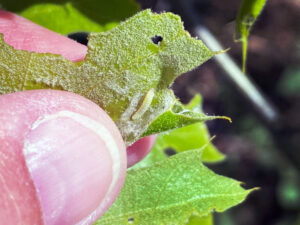
Oak leaftier is a native caterpillar that causes damage similar to that caused by oak leafroller.
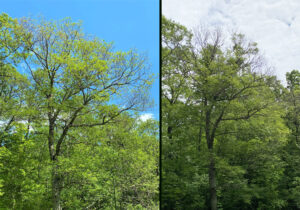
Two consecutive years of defoliation by oak leafroller has led to significant crown dieback and decline of this oak pictured in June 2022 (left) and again in June 2024 (right). Several years of recovery, as well as some oak mortality, can be expected for multiple, consecutive years. / Photo Credit: Paul Cigan, Wisconsin DNR
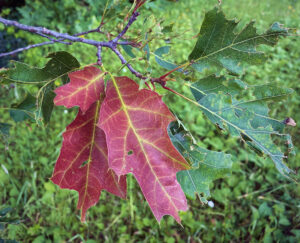
Red oaks will usually produce a second flush of leaves following heavy oak leafroller defoliation in spring, and young leaves may display a red pigmentation due to high concentrations of a group of foliar pigments called anthocyanins. / Photo Credit: Paul Cigan, Wisconsin DNR

An adult oak leafroller moth. / Photo Credit: Paul Cigan, Wisconsin DNR
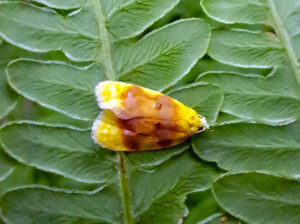
An adult oak leaftier moth. / Photo Credit: Paul Cigan, Wisconsin DNR.
